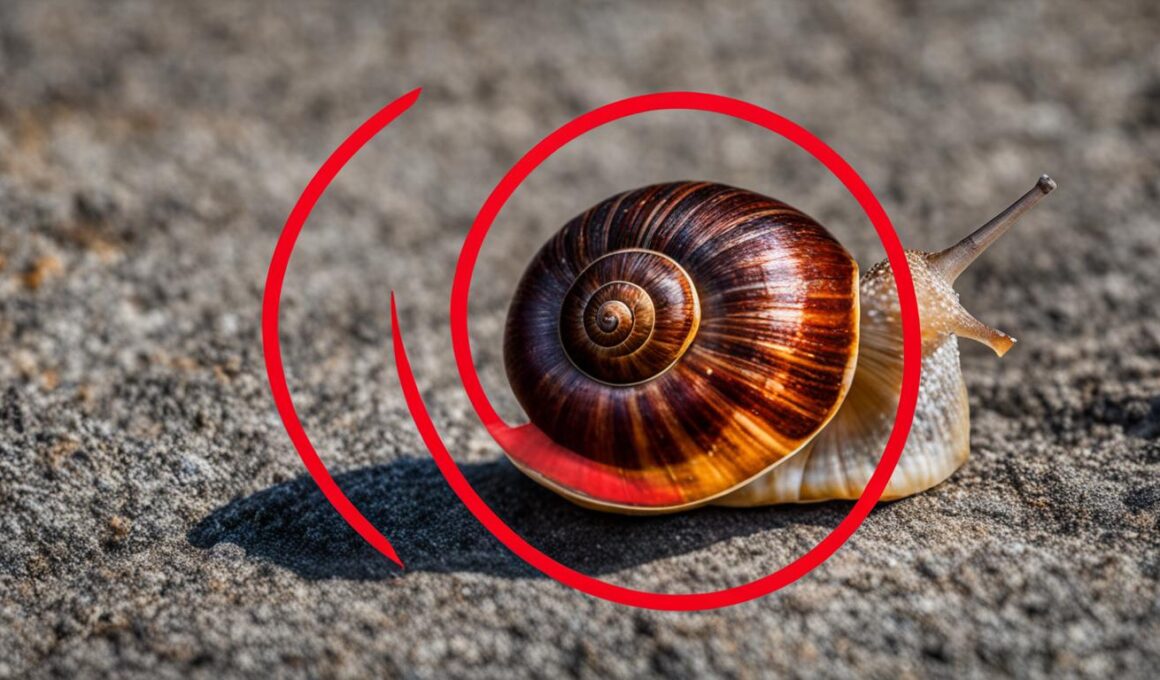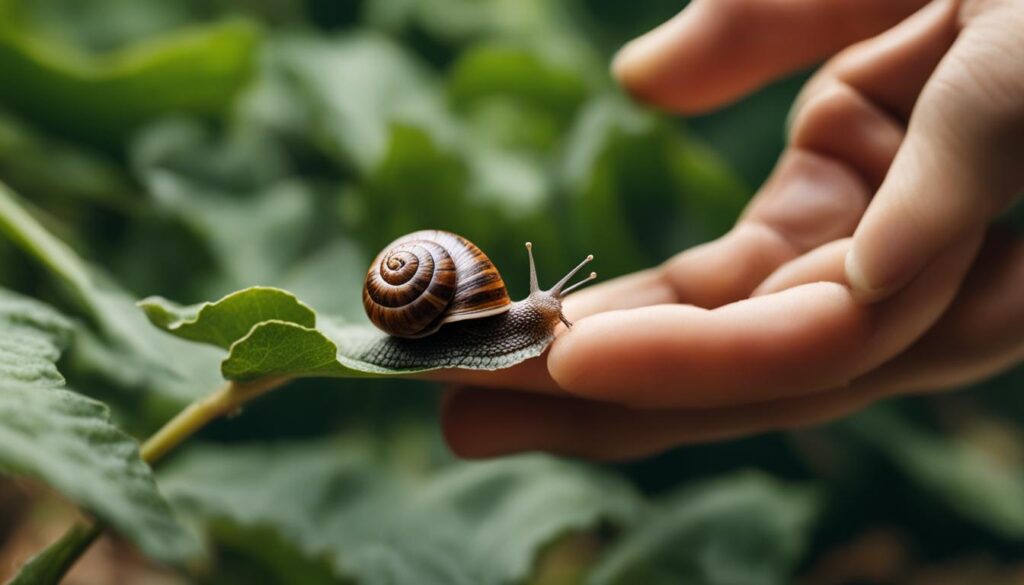Snails can be a major problem in gardens, causing damage to plants and flowers. To effectively get rid of snails in your garden, there are several eco-friendly methods you can use.
These include identifying their presence, handpicking them off, setting up traps, creating an unfavorable habitat, using barriers, switching to drip irrigation, growing plants they don’t like, and applying an organic slug bait. By implementing these methods, you can ensure a snail-free garden and protect your plants from their destructive tendencies.
Key Takeaways:
- Identify signs of a snail infestation, such as extensible eyestalks, silvery slime trails, and chewed holes in plant leaves.
- Regularly check for snails in low-growing foliage, the soil underneath plants, and shaded areas.
- Handpick snails wearing gloves and dispose of them in a bucket of soapy water.
- Set traps using inverted grapefruit or melon rinds, flat boards, or shallow containers filled with beer.
- Create an unfavorable habitat for snails by removing plant debris, keeping areas between plants drier, and thinning and dividing plants for better air circulation.
Identify Their Presence
Before taking action to get rid of snails in your garden, it’s important to first identify whether you have a snail infestation. By recognizing the signs of snails in your garden, you can address the issue promptly and effectively.
Snails are most active at night or on cloudy days when the soil is cool and damp. Keep an eye out for silvery slime trails on the ground, as snails leave these behind as they move. Additionally, check for chewed holes in plant leaves, as snails feed on foliage. Look for their extensible eyestalks, which help them navigate their surroundings.
When inspecting your garden, pay particular attention to low-growing foliage, the soil underneath plants, and shaded areas, as snails tend to hide in these spots during the day. By regularly checking for snails and identifying their presence, you can take appropriate action to control their population and protect your plants from their feeding habits.
| Signs of Snails in the Garden | How to Identify Snails |
|---|---|
| Extensible eyestalks | Look for eyestalks protruding from the snail’s head |
| Silvery slime trails | Check the ground for shiny trails left behind by snails |
| Chewed holes in plant leaves | Inspect foliage for irregularly-shaped holes |
By being able to identify the presence of snails in your garden, you can take the necessary steps to manage their population and minimize the damage they cause to your plants.
Handpicking Snails: A Manual Approach to Organic Snail Control
If you’re looking for an effective and eco-friendly method to rid your garden of snails, handpicking is a simple yet highly efficient solution. By manually removing snails from your plants, you can protect them from destructive feeding habits and maintain a healthy garden ecosystem.
To begin, equip yourself with a pair of gloves to avoid direct contact with the snails. Taking a walk through your garden in the evening or early morning when snails are most active, carefully inspect the leaves and stems of your plants. Look for these slow-moving pests with their recognizable extensible eyestalks and the silvery slime trails they leave behind.
When you spot a snail, gently pick it off the plant and deposit it into a bucket filled with soapy water. This method ensures the snails are effectively disposed of without causing harm to the environment. For best results, make handpicking a regular routine to keep snail populations under control and safeguard the health of your garden.
Benefits of Handpicking Snails:
- Organic and chemical-free solution
- Immediate and direct method of snail removal
- Reduces snail populations effectively
- Prevents further damage to plants
- Safe for pets, wildlife, and the environment
By incorporating handpicking as part of your snail control strategy, you can maintain a healthy garden without the need for harmful chemicals or pesticides. With a little effort and a pair of gloves, you can successfully keep snails at bay and enjoy the beauty of your plants.
Set a Trap
If you’re looking for an effective and natural way to control snails in your garden, setting up traps is a great option. Snail traps can help you reduce their population and protect your plants from their destructive feeding habits. There are a few different types of traps you can use to attract and capture snails.
One popular trap is the beer trap. Snails are attracted to the yeasty aroma of beer, so you can set up shallow containers filled with beer in your garden. The snails will crawl into the trap and drown. Make sure to check and empty the traps regularly to keep them effective.
You can also create a shady retreat for snails using flat boards. Snails like to take shelter in cool, dark places during hot days. Place the boards in your garden, and snails will gather underneath them. You can then easily collect and remove them. This method is particularly useful if you have a large garden or a severe snail infestation.
By setting up traps in your garden, you can significantly reduce the number of snails and protect your plants from their destructive feeding habits. Remember to check and empty the traps regularly, and experiment with different trap types to find the most effective solution for your garden.
Create an Unfavorable Habitat
Snails are attracted to moist, shady spots in the garden, as well as areas that are heavily mulched. To deter snails and create an unfavorable habitat for them, practicing good garden maintenance is essential.
Firstly, remove plant debris and dead leaves regularly. These can provide hiding places and moisture that snails thrive on. By keeping the garden clean, you make it less appealing to snails and reduce their habitat.
Secondly, be mindful of mulch usage. Apply mulch at a thickness no greater than 3 inches and keep it away from the base of plants. Snails often burrow through mulch, using it as a pathway. By limiting their access, you make it more difficult for them to move around the garden and find shelter.
Additionally, improving air circulation by thinning and dividing plants can help to dry out the soil surface. Snails prefer damp conditions, so by creating drier areas, you discourage their presence. This can be achieved by spacing out plants, removing overcrowded areas, and ensuring proper drainage in the garden.
By following these practices, you can make your garden a less favorable habitat for snails. This will help to deter them from taking up residence and reduce the damage they can cause to your plants.
Will Getting Rid of Snails Help Protect My Squash from Vine Borer?
Getting rid of snails may help protect squash from vine borer. Snails can damage plants and leave them vulnerable to other pests, including vine borers. By eliminating snails, you can create a healthier environment for your squash and reduce the risk of infestation from vine borers.
Apply an Organic Slug Bait
If you prefer to take a bait-based approach to get rid of snails, there are organic options available that are both effective and safe for the environment. Look for organic slug baits that contain iron phosphate. These baits are considered environmentally-friendly and can be used around pets, wildlife, and fruits or vegetables ready for harvest.
One benefit of using organic slug bait is that it remains effective even after rain or watering. It is recommended to apply the bait in the late afternoon or evening when snails are most active. By using an organic slug bait, you can effectively control snail populations without causing harm to the environment.
It’s important to avoid using chemical slug baits or pellets that contain metaldehyde, as these can be toxic to people and pets. By choosing an organic snail bait, you can ensure the safety of your garden and the creatures that inhabit it.
FAQ
How can I identify if I have a snail infestation in my garden?
You can look for signs of snails such as extensible eyestalks, silvery slime trails, and chewed holes in plant leaves. Check low-growing foliage, the soil underneath plants, and shaded areas, as snails tend to hide in these areas during the day.
What is the most effective way to handpick snails from my garden?
Simply pick them off by hand (wearing gloves to avoid direct contact) and dispose of them in a bucket of soapy water. Regularly checking and handpicking snails, especially after dusk or early in the morning when they are most active, can significantly reduce their numbers.
How do I set up a trap to catch snails in my garden?
You can use inverted grapefruit or melon rinds, flat boards, or shallow containers filled with beer to attract and trap snails. Snails are attracted to the yeasty aroma of beer and will crawl into the trap and drown. Alternatively, you can create a shady retreat for them using flat boards, where they can take shelter on hot days and can be easily collected and removed.
What can I do to create an unfavorable habitat for snails in my garden?
Snails love moist, shady spots and areas that are heavily mulched. By removing plant debris and dead leaves, keeping the areas between plants drier, and applying mulch at a thickness no greater than 3 inches and away from the base of plants, you can make the habitat less favorable for snails. Improving air circulation by thinning and dividing plants can also discourage snails from using them as pathways through the garden.
Can I use a slug bait to control snails in an eco-friendly way?
Yes, there are organic slug baits available that contain iron phosphate. These baits are safe for use around pets, wildlife, and fruits or vegetables ready for harvest. They remain effective after rain or watering and can be applied in the late afternoon or evening when snails are most active. Avoid using chemical slug baits or pellets that contain metaldehyde, as these can be toxic to people and pets.











